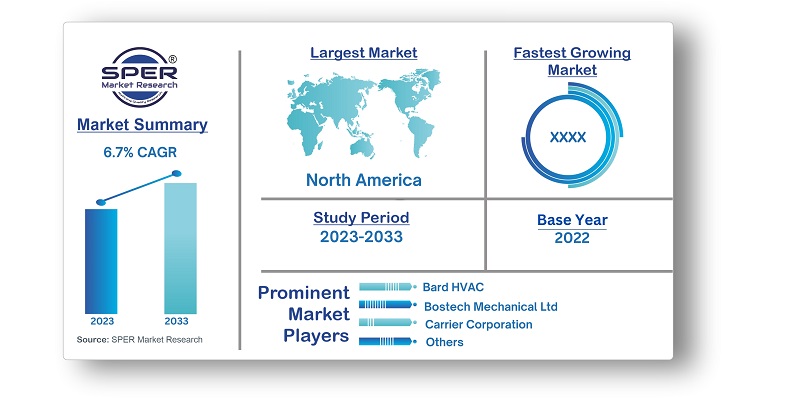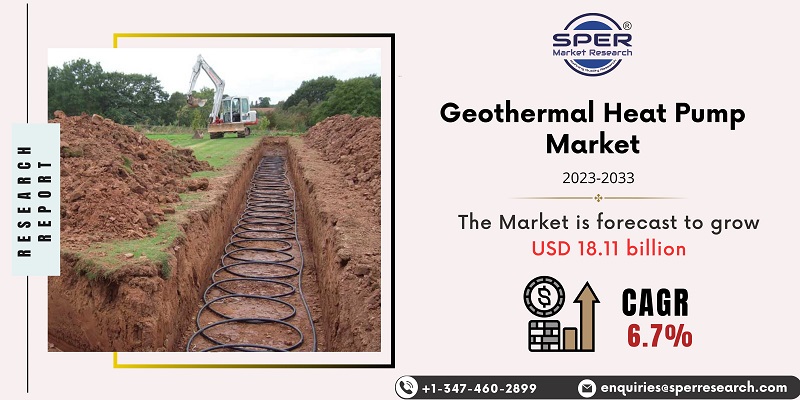
Geothermal Heat Pump Market Growth, Size, Trends, Revenue, Demand, Share and Future Outlook
Geothermal Heat Pump Market Size- By Type, By Application- Regional Outlook, Competitive Strategies and Segment Forecast to 2033
| Published: Nov-2023 | Report ID: POAE2379 | Pages: 1 - 244 | Formats*: |
| Category : Power & Energy | |||
- September 2018: After working with the Federal Electricity Commission, the National Institute of Electricity and Clean Energy (INEEL) erected the first geothermal heat pump system for residential air conditioning in September 2018.
- November 2022: NGP's energy transition investing division and Lennar, a significant national homebuilder, provided funding for Dandelion Energy's USD 70 million fundraising drive to expand its activities in the United States. Condensed geothermal drilling is used in the backyard of a home to fuel heat pumps powered by dandelions.


| Report Metric | Details |
| Market size available for years | 2019-2033 |
| Base year considered | 2022 |
| Forecast period | 2023-2033 |
| Segments covered | By Type, By Application |
| Regions covered | North America, Asia-Pacific, Latin America, Middle East & Africa and Europe |
| Companies Covered | Bard HVAC, Bostech Mechanical Ltd., Carrier Corporation, ClimateMaster, Inc., Daikin Industries Ltd., Dandelion, De Dietrich S.A.S., Ecoforest S.A., EnergySmart Alternatives, Free Energy Innovations, Maritime Geothermal Ltd., Mitsubishi Electric Corporation, Pfister Energy, Robert Bosch LLC, Sauer-Danfoss Inc., Spectrum Manufacturing, Wolf GmbH, Others |
- Commercial and Industrial Sector
- Energy and Environmental Organizations
- Government and Regulatory Bodies
- HVAC System Manufacturers and Suppliers
- Research and Development Institutions
- Residential Sector
- Utilities and Energy Service Companies (ESCOs)
- Others
| By Type: |
|
| By Application: |
|
| By Region: |
|
- Global Geothermal Heat Pump Market Size (FY’2023-FY’2033)
- Overview of Global Geothermal Heat Pump Market
- Segmentation of Global Geothermal Heat Pump Market By Type (Closed Loop Systems, Open Loop Systems)
- Segmentation of Global Geothermal Heat Pump Market By Application (Commercial, Industrial, Residential)
- Statistical Snap of Global Geothermal Heat Pump Market
- Expansion Analysis of Global Geothermal Heat Pump Market
- Problems and Obstacles in Global Geothermal Heat Pump Market
- Competitive Landscape in the Global Geothermal Heat Pump Market
- Impact of COVID-19 and Demonetization on Global Geothermal Heat Pump Market
- Details on Current Investment in Global Geothermal Heat Pump Market
- Competitive Analysis of Global Geothermal Heat Pump Market
- Prominent Players in the Global Geothermal Heat Pump Market
- SWOT Analysis of Global Geothermal Heat Pump Market
- Global Geothermal Heat Pump Market Future Outlook and Projections (FY’2023-FY’2033)
- Recommendations from Analyst
1.1. Scope of the report1.2. Market segment analysis
2.1. Research data Source2.1.1. Secondary Data2.1.2. Primary Data2.1.3. SPER’s internal database2.1.4. Premium insight from KOL’s2.2. Market size estimation2.2.1. Top-down and Bottom-up approach2.3. Data triangulation
4.1. Driver, Restraint, Opportunity and Challenges analysis4.1.1. Drivers4.1.2. Restraints4.1.3. Opportunities4.1.4. Challenges4.2. COVID-19 Impacts of the Global Geothermal Heat Pump Market
5.1. SWOT Analysis5.1.1. Strengths5.1.2. Weaknesses5.1.3. Opportunities5.1.4. Threats5.2. PESTEL Analysis5.2.1. Political Landscape5.2.2. Economic Landscape5.2.3. Social Landscape5.2.4. Technological Landscape5.2.5. Environmental Landscape5.2.6. Legal Landscape5.3. PORTER’s Five Forces5.3.1. Bargaining power of suppliers5.3.2. Bargaining power of buyers5.3.3. Threat of Substitute5.3.4. Threat of new entrant5.3.5. Competitive rivalry5.4. Heat Map Analysis
6.1. Global Geothermal Heat Pump Market Manufacturing Base Distribution, Sales Area, Product Type6.2. Mergers & Acquisitions, Partnerships, Product Launch, and Collaboration in Global Geothermal Heat Pump Market
7.1. Global Geothermal Heat Pump Market Value Share and Forecast, By Type, 2023-20337.2. Closed Loop Systems7.2.1. Horizontal7.2.2. Vertical7.3. Open Loop Systems
8.1. Global Geothermal Heat Pump Market Value Share and Forecast, By Application, 2023-20338.2. Commercial8.3. Industrial8.4. Residential
9.1. Global Geothermal Heat Pump Market Size and Market Share
10.1. Global Geothermal Heat Pump Market Size and Market Share By Type (2019-2026)10.2. Global Geothermal Heat Pump Market Size and Market Share By Type (2027-2033)
11.1. Global Geothermal Heat Pump Market Size and Market Share By Application (2019-2026)11.2. Global Geothermal Heat Pump Market Size and Market Share By Application (2027-2033)
12.1. Global Geothermal Heat Pump Market Size and Market Share By Region (2019-2026)12.2. Global Geothermal Heat Pump Market Size and Market Share By Region (2027-2033)12.3. Asia-Pacific12.3.1. Australia12.3.2. China12.3.3. India12.3.4. Japan12.3.5. South Korea12.3.6. Rest of Asia-Pacific12.4. Europe12.4.1. France12.4.2. Germany12.4.3. Italy12.4.4. Spain12.4.5. United Kingdom12.4.6. Rest of Europe12.5. Middle East and Africa12.5.1. Kingdom of Saudi Arabia12.5.2. United Arab Emirates12.5.3. Rest of Middle East & Africa12.6. North America12.6.1. Canada12.6.2. Mexico12.6.3. United States12.7. Latin America12.7.1. Argentina12.7.2. Brazil12.7.3. Rest of Latin America
13.1. Bard HVAC13.1.1. Company details13.1.2. Financial outlook13.1.3. Product summary13.1.4. Recent developments13.2. Bostech Mechanical Ltd13.2.1. Company details13.2.2. Financial outlook13.2.3. Product summary13.2.4. Recent developments13.3. Carrier Corporation13.3.1. Company details13.3.2. Financial outlook13.3.3. Product summary13.3.4. Recent developments13.4. ClimateMaster, Inc.13.4.1. Company details13.4.2. Financial outlook13.4.3. Product summary13.4.4. Recent developments13.5. Daikin Industries Ltd.13.5.1. Company details13.5.2. Financial outlook13.5.3. Product summary13.5.4. Recent developments13.6. Dandelion13.6.1. Company details13.6.2. Financial outlook13.6.3. Product summary13.6.4. Recent developments13.7. De Dietrich S.A.S.13.7.1. Company details13.7.2. Financial outlook13.7.3. Product summary13.7.4. Recent developments13.8. Ecoforest S.A.13.8.1. Company details13.8.2. Financial outlook13.8.3. Product summary13.8.4. Recent developments13.9. EnergySmart Alternatives13.9.1. Company details13.9.2. Financial outlook13.9.3. Product summary13.9.4. Recent developments13.10. Free Energy Innovations13.10.1. Company details13.10.2. Financial outlook13.10.3. Product summary13.10.4. Recent developments13.11. Maritime Geothermal Ltd13.11.1. Company details13.11.2. Financial outlook13.11.3. Product summary13.11.4. Recent developments13.12. Mitsubishi Electric Corporation13.12.1. Company details13.12.2. Financial outlook13.12.3. Product summary13.12.4. Recent developments13.13. Pfister Energy13.13.1. Company details13.13.2. Financial outlook13.13.3. Product summary13.13.4. Recent developments13.14. Robert Bosch LLC13.14.1. Company details13.14.2. Financial outlook13.14.3. Product summary13.14.4. Recent developments13.15. Sauer-Danfoss Inc.13.15.1. Company details13.15.2. Financial outlook13.15.3. Product summary13.15.4. Recent developments13.16. Spectrum Manufacturing13.16.1. Company details13.16.2. Financial outlook13.16.3. Product summary13.16.4. Recent developments13.17. Wolf GmbH13.17.1. Company details13.17.2. Financial outlook13.17.3. Product summary13.17.4. Recent developments13.18. Others
SPER Market Research’s methodology uses great emphasis on primary research to ensure that the market intelligence insights are up to date, reliable and accurate. Primary interviews are done with players involved in each phase of a supply chain to analyze the market forecasting. The secondary research method is used to help you fully understand how the future markets and the spending patterns look likes.
The report is based on in-depth qualitative and quantitative analysis of the Product Market. The quantitative analysis involves the application of various projection and sampling techniques. The qualitative analysis involves primary interviews, surveys, and vendor briefings. The data gathered as a result of these processes are validated through experts opinion. Our research methodology entails an ideal mixture of primary and secondary initiatives.



Frequently Asked Questions About This Report
PLACE AN ORDER
Year End Discount
Sample Report
Pre-Purchase Inquiry
NEED CUSTOMIZATION?
Request CustomizationCALL OR EMAIL US
100% Secure Payment






Related Reports
Our Global Clients
Our data-driven insights have influenced the strategy of 200+ reputed companies across the globe.




















